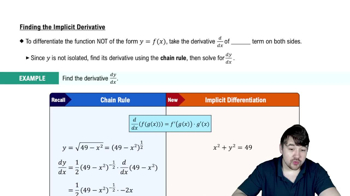Table of contents
- 0. Functions7h 52m
- Introduction to Functions16m
- Piecewise Functions10m
- Properties of Functions9m
- Common Functions1h 8m
- Transformations5m
- Combining Functions27m
- Exponent rules32m
- Exponential Functions28m
- Logarithmic Functions24m
- Properties of Logarithms34m
- Exponential & Logarithmic Equations35m
- Introduction to Trigonometric Functions38m
- Graphs of Trigonometric Functions44m
- Trigonometric Identities47m
- Inverse Trigonometric Functions48m
- 1. Limits and Continuity2h 2m
- 2. Intro to Derivatives1h 33m
- 3. Techniques of Differentiation3h 18m
- 4. Applications of Derivatives2h 38m
- 5. Graphical Applications of Derivatives6h 2m
- 6. Derivatives of Inverse, Exponential, & Logarithmic Functions2h 37m
- 7. Antiderivatives & Indefinite Integrals1h 26m
- 8. Definite Integrals3h 25m
4. Applications of Derivatives
Implicit Differentiation
Problem 3.8.63d
Textbook Question
Witch of Agnesi Let y(x²+4)=8 (see figure). <IMAGE>
d. Verify that the results of parts (a) and (c) are consistent.
 Verified step by step guidance
Verified step by step guidance1
Start by rewriting the given equation y(x² + 4) = 8 in terms of y to isolate it: y = 8 / (x² + 4).
Recognize that this equation represents a function, which can be analyzed for its properties such as symmetry, intercepts, and behavior as x approaches infinity.
Determine the vertex of the curve by finding the minimum value of the denominator (x² + 4) since it is always positive, which occurs at x = 0.
Calculate the value of y at the vertex by substituting x = 0 into the equation: y(0) = 8 / (0² + 4).
Finally, verify the consistency of results from parts (a) and (c) by comparing the derived properties of the curve with the expected characteristics of the Witch of Agnesi.
Recommended similar problem, with video answer:
 Verified Solution
Verified SolutionThis video solution was recommended by our tutors as helpful for the problem above
Video duration:
6mPlay a video:
Was this helpful?

 5:14m
5:14mWatch next
Master Finding The Implicit Derivative with a bite sized video explanation from Nick
Start learningRelated Videos
Related Practice



